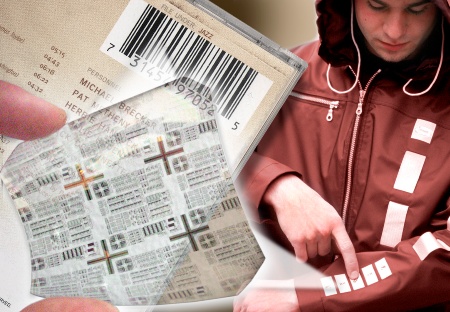Infineon First to Integrate Plastic Chips on Commercially Available Packaging Film
Munich, November 12, 2002 As a world premiere, a team of scientists from Infineon now succeeded in integrating plastics electronic circuits on commercially available packaging film. Before, this was only possible with the use of very high quality plastic materials. Now an important requirement has been met to produce the low-cost chips in a reel-to-reel process in high volumes. Similar to the newspaper printing process, this process runs the film through several coating and surfacing phases at high speed. The trick: The scientists apply the active and most sensitive layer of the thin-film transistor not as the first of the individual chip layers to the plastic substrate, but as the last layer. Among the most envisioned applications are flexible RFID tags (Radio Frequency Identification). The plastic RF tags are expected to be available in a few years to replace the well-known barcodes in the market. If every newly produced item were to be equipped with these tags, industry experts estimate that more than 500 billion of such chips would have to be produced annually.
The existence of plastics that can also become semiconductors depending on their molecular structure has been known since 1977. Since then, the race has been on for practical applications. Aside from the arrangement of the layers, another factor that enabled the breakthrough development in the Infineon labs was the choice of materials. The researchers there relied on so-called small molecules. Contrary to the commonly used polymers, these exhibit higher charge carrier mobilities due to their highly ordered crystalline structure. In addition, their processing neither requires any toxic chlorinated solvents, nor expensive chromatography to purify the materials. Another advantage: Many common plastic bags, e.g. for potato chips, are aluminized. This aluminum layer, which usually serves as an oxygen barrier to keep the food fresh, can be patterned in a flexo-type printing process to obtain the necessary interconnect structure for electronic circuitry. Currently, the printed aluminum structures of 5 µm have a width of one tenth of an average human hair. Conventional structures of silicon-based chips have critical dimensions down to 130 nanometers, 400 times smaller than the thickness of a human hair.
According to Infineon, there are several possible ways to market the new technology. The plastic chips will either be glued to packaged goods in the form of finished labels, or the semiconductor industry will supply the packaging film ready with integrated electronic components for further processing. Last but not least, it will be the turn of the packaging industry itself to bring the development to the market. Eventually, the plastic chips will be printed on the packaging together with the regular product information. After all, the profitability of this technology will depend on mass production processes. Devices that can read barcodes as well as RF chips are already available. Advantages of RFID tags over barcodes include the fact that they do not require a line-of-sight connection to the reader. In this manner, the reading can literally be handled in passing.
The Subtle Difference: the Choice of Materials
The existence of plastics that can also become semiconductors depending on their molecular structure has been known since 1977. Since then, the race has been on for practical applications. Aside from the arrangement of the layers, another factor that enabled the breakthrough development in the Infineon labs was the choice of materials. The researchers there relied on so-called small molecules. Contrary to the commonly used polymers, these exhibit higher charge carrier mobilities due to their highly ordered crystalline structure. In addition, their processing neither requires any toxic chlorinated solvents, nor expensive chromatography to purify the materials. Another advantage: Many common plastic bags, e.g. for potato chips, are aluminized. This aluminum layer, which usually serves as an oxygen barrier to keep the food fresh, can be patterned in a flexo-type printing process to obtain the necessary interconnect structure for electronic circuitry. Currently, the printed aluminum structures of 5 µm have a width of one tenth of an average human hair. Conventional structures of silicon-based chips have critical dimensions down to 130 nanometers, 400 times smaller than the thickness of a human hair.
Now its the industrys turn
According to Infineon, there are several possible ways to market the new technology. The plastic chips will either be glued to packaged goods in the form of finished labels, or the semiconductor industry will supply the packaging film ready with integrated electronic components for further processing. Last but not least, it will be the turn of the packaging industry itself to bring the development to the market. Eventually, the plastic chips will be printed on the packaging together with the regular product information. After all, the profitability of this technology will depend on mass production processes. Devices that can read barcodes as well as RF chips are already available. Advantages of RFID tags over barcodes include the fact that they do not require a line-of-sight connection to the reader. In this manner, the reading can literally be handled in passing.
About Infineon
Infineon Technologies AG, Munich, Germany, offers semiconductor and system solutions for the automotive and industrial sectors, for applications in the wired communications markets, secure mobile solutions as well as memory products. With a global presence, Infineon operates in the US from San Jose, CA, in the Asia-Pacific region from Singapore and in Japan from Tokyo. In the fiscal year 2002 (ending September), the company achieved sales of Euro 5.21 billion with about 30,400 employees worldwide. Infineon is listed on the DAX index of the Frankfurt Stock Exchange and on the New York Stock Exchange (ticker symbol: IFX). Further information is available at www.infineon.com
Information Number
INFCPR200211.017e
Press Photos
-
 Infineon First to Integrate Plastic Chips on Commercially Available Packaging FilmPress Picture
Infineon First to Integrate Plastic Chips on Commercially Available Packaging FilmPress PictureJPG | 695 kb | 1535 x 1063 px
